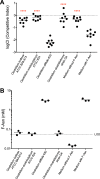Identification of Bacterial Species That Can Utilize Fructose-Asparagine
- PMID: 29269489
- PMCID: PMC5812934
- DOI: 10.1128/AEM.01957-17
Identification of Bacterial Species That Can Utilize Fructose-Asparagine
Abstract
Salmonella enterica serovar Typhimurium is the only organism demonstrated to utilize fructose-asparagine (F-Asn) as a source of carbon and nitrogen. In this report, we first used a bioinformatics approach to identify other microorganisms that encode homologs of the Salmonella F-Asn utilization enzymes FraB (deglycase), FraD (kinase), and FraE (asparaginase). These candidate organisms were then tested with up to four different methods to confirm their ability to utilize F-Asn. The easiest and most broadly applicable method utilized a biological toxicity assay, which is based on the observation that F-Asn is toxic to a Salmonella fraB mutant. Candidate organisms were grown in a rich medium containing F-Asn, and depletion of F-Asn from the medium was inferred by the growth of a Salmonella fraB mutant in that same medium. For select organisms, the toxicity assay was cross-validated by direct mass spectrometry-aided measurement of F-Asn in the spent-culture media and through demonstration of FraB and FraD enzyme activity in cellular extracts. For prototrophs, F-Asn utilization was additionally confirmed by growth in a minimal medium containing F-Asn as the sole carbon source. Collectively, these studies established that Clostridiumbolteae, Clostridium acetobutylicum, and Clostridium clostridioforme can utilize F-Asn, but Clostridium difficile cannot; Klebsiella oxytoca and some Klebsiella pneumoniae subspecies can utilize F-Asn; and some Citrobacter rodentium and Citrobacter freundii strains can also utilize F-Asn. Within Salmonella enterica, the host-adapted serovars Typhi and Paratyphi A have lost the ability to utilize F-Asn.IMPORTANCE Fructose-asparagine (F-Asn) is a precursor to acrylamide that is found in human foods, and it is also a nutrient source for Salmonella enterica, a foodborne pathogen. Here, we determined that among the normal intestinal microbiota, there are species of Clostridium that encode the enzymes required for F-Asn utilization. Using complementary experimental approaches, we have confirmed that three members of Clostridium, two members of Klebsiella, and two members of Citrobacter can indeed utilize F-Asn. The Clostridium spp. likely compete with Salmonella for F-Asn in the gut and contribute to competitive exclusion. FraB, one of the enzymes in the F-Asn utilization pathway, is a potential drug target because inhibition of this enzyme leads to the accumulation of a toxic metabolite that inhibits the growth of Salmonella species. This study identifies the potential off-target organisms that need to be considered when developing therapeutics directed at FraB.
Keywords: Amadori products; Citrobacter; Clostridium; FraB; Klebsiella; Salmonella; fructosamines; fructose-asparagine; pathovar; phylogeny; typhoid.
Copyright © 2018 American Society for Microbiology.
Figures






References
-
- Kotloff KL, Nataro JP, Blackwelder WC, Nasrin D, Farag TH, Panchalingam S, Wu Y, Sow SO, Sur D, Breiman RF, Faruque AS, Zaidi AK, Saha D, Alonso PL, Tamboura B, Sanogo D, Onwuchekwa U, Manna B, Ramamurthy T, Kanungo S, Ochieng JB, Omore R, Oundo JO, Hossain A, Das SK, Ahmed S, Qureshi S, Quadri F, Adegbola RA, Antonio M, Hossain MJ, Akinsola A, Mandomando I, Nhampossa T, Acácio S, Biswas K, O'Reilly CE, Mintz ED, Berkeley LY, Muhsen K, Sommerfelt H, Robins-Browne RM, Levine MM. 2013. Burden and aetiology of diarrhoeal disease in infants and young children in developing countries (the Global Enteric Multicenter Study, GEMS): a prospective, case-control study. Lancet 382:209–222. doi: 10.1016/S0140-6736(13)60844-2. - DOI - PubMed
-
- Pires SM, Fischer-Walker CL, Lanata CF, Devleesschauwer B, Hall AJ, Kirk MD, Duarte ASR, Black RE, Angulo FJ. 2015. Aetiology-specific estimates of the global and regional incidence and mortality of diarrhoeal diseases commonly transmitted through food. PLoS One 10:e0142927. doi: 10.1371/journal.pone.0142927. - DOI - PMC - PubMed
-
- Scallan E, Mahon BE, Hoekstra RM, Griffin PM. 2013. Estimates of illnesses, hospitalizations and deaths caused by major bacterial enteric pathogens in young children in the United States. Pediatr Infect Dis J 32:217–221. - PubMed
Publication types
MeSH terms
Substances
Grants and funding
LinkOut - more resources
Full Text Sources
Other Literature Sources
Molecular Biology Databases
Miscellaneous

